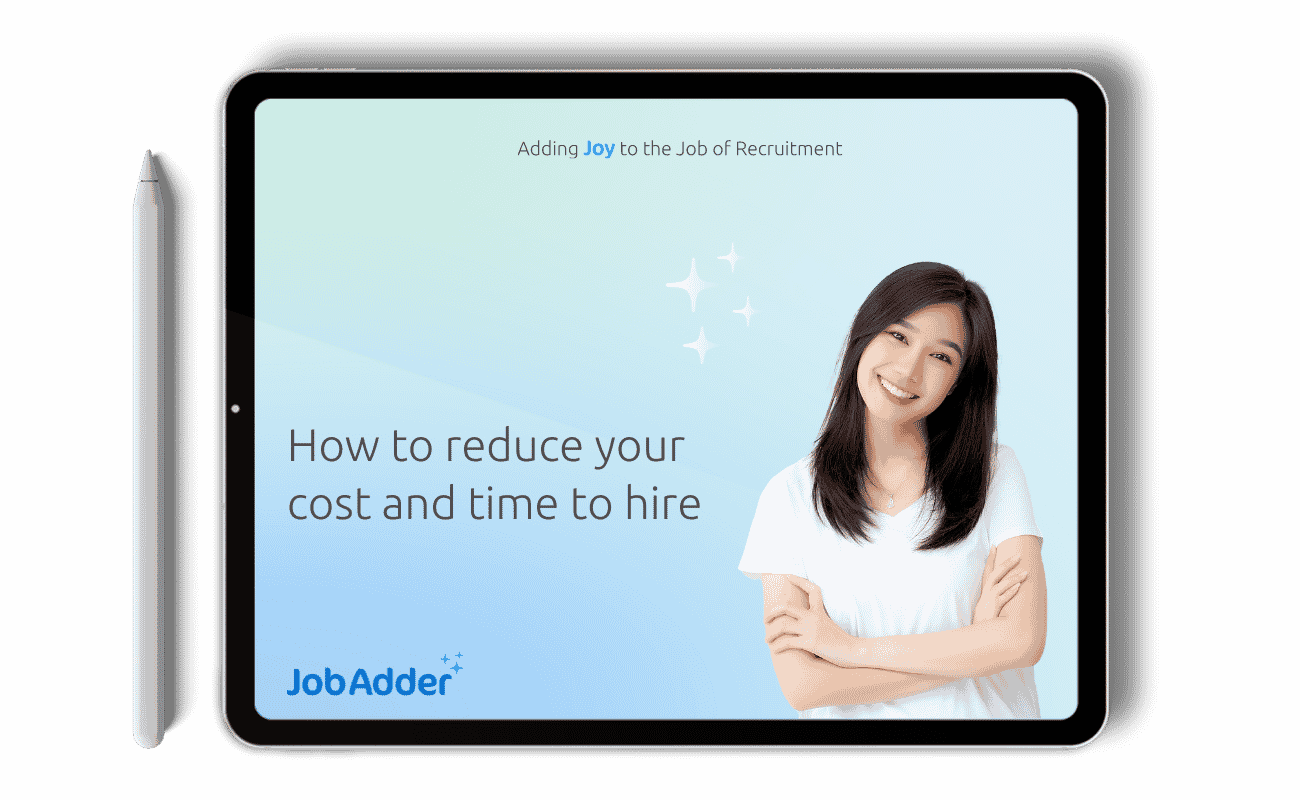While hiring new employees can be incredibly exciting, the onboarding process also takes up a bunch of time and energy.
A strategic and effective onboarding program is crucial to ensure you’re setting up new employees for success.
There are a number of ways that you can constantly improve the onboarding experience for both you and your new hires.
By taking the time to do this now, you can help integrate new staff into your team quickly and improve the overall employee experience.
In this blog, we’ll explore what exactly the employee onboarding process entails and some tips that can help you improve your onboarding program.
FREE EBOOK: How to reduce your cost and time to hire
What is the employee onboarding process?
A company’s employee onboarding process creates a first impression that can significantly impact your business’s success or failure.
New hire onboarding is how new hires are integrated into your company’s values and trained to be effective, productive employees. New hires must understand how to do their job and work well with their new team.
A good new hires onboarding process ensures that employees get off to the right start with your company policies and feel welcomed into your workplace.
The first step of an onboarding process is typically a job offer letter. These letters help employers and employees avoid confusion about crucial aspects of their employment relationship and other vital responsibilities.
After the offer letter is accepted, you can send out a simple welcome email outlining key company values and company policies they should be aware of. From there, you can start preparing for their start date.
It’s important to note that the onboarding process doesn’t stop after the employee’s first day when the new hire paperwork is filled out. The onboarding process encompasses the entire period from the time they receive a job offer to when they’re comfortable in their new role.
This includes everything from training, meeting their new team and co-workers, and learning about their work environment. This process can last anywhere from their first month to their first 90 days (or more), depending on how you want to structure your onboarding program.
11 tips for new employee onboarding
An employee’s first week at your company can be the most critical period in determining whether they will become an engaged and productive member of your team.
To get the most out of your onboarding process, HR professionals and hiring managers alike should look for ways to improve the onboarding process.
If you’re looking to give new employees some insight into their new job and company culture, these 11 practical onboarding tips for new hires will guide you. These onboarding tips will ensure your new hires are ready to hit the ground running when they join your team.
Make sure you’re prepared for their first day
The first day can be overwhelming for both you and your new hire. They will be involved in many meetings, meet many people and learn about their new job.
They must know exactly what you expect of them from day one and who they should go to if they have any questions.
You’ll want to make sure they have all of their paperwork in order, know where they’re going and schedule when and where they’ll meet with various team members.
This guidance will help them feel more comfortable and help you create a more cohesive company culture. It’s also good practice to give them a workplace tour on their first day.
You could also organise a few team-building activities during their first week to better help new employees get to know their coworkers. If possible, try and get everyone together at least once during this first week so they can hear from various members of management and fellow colleagues.
Use an onboarding software to automate tasks
The use of onboarding software is growing in popularity. While many companies are still using traditional methods, there is a movement toward digital solutions that automate most manual workflows. Automation can help streamline processes and save time for any HR department.
Automation ensures consistency throughout your organisation so that employees get what they need when they need it. This includes payment procedures for direct deposits of their salaries, retirement contributions or simply the gathering of personal details securely. This can lead to better retention rates because employees feel their needs are being met and that they know where to go if something isn’t working correctly.
Onboarding software also allows you to measure how effective your onboarding process is by tracking metrics like retention rates.
You can also easily manage and track your employees’ progress with an online software platform with a built-in reporting feature. This streamlined approach will help improve communication between departments and reduce bottlenecks as you learn how to onboard new hires.
Assign a work partner
When new hires join a company, they’re often thrown into an environment with no idea what’s going on. It can be intimidating and overwhelming, especially as they seek a sense of belonging in their new company.
Assigning a work partner or mentor is one way to ensure that your new hire has someone there with them who can guide them throughout their first few weeks.
Onboarding programs often assign interns, new hires and entry-level employees a buddy who can walk them through their first few weeks. This person should be someone you trust, who’s welcoming and an experienced team member.
The company culture will also be easier to grasp if they can talk to a coworker who understands it.
Schedule regular check-ins
When hiring new employees, clear communication is vital. Schedule regular check-ins with them to ensure you’re on track and that your company is a good fit for your new hire.
Keeping these meetings brief and conversational is essential since you don’t want them to feel like you’re interrogating them. These check-ins also ensure that your new hire stays motivated throughout their time at your company.
Asking for feedback is also a great way to get insight into what your new hire thinks about their role and what could be improved. This also helps foster a sense of community and collaboration within your organisation and makes everyone feel included.
Let your team members know that you’re always available if they have any questions or concerns. The more information you have about how others perceive your business, the better equipped you’ll be to work out any problems before they escalate into more significant issues.
Create an onboarding checklist
The onboarding process sometimes proves overwhelming, but it doesn’t have to be. Creating an onboarding checklist for new hires ensures that your new employees have a smooth onboarding experience. It will also help you track the complete and incomplete tasks.
Employee benefits, health insurance and an employee orientation program covering company policies and procedures are great places to start. You can create a basic template that includes essential information such as crucial training, certifications required and contact information.
With such a template, you can easily plug in new information when you need to. This checklist will enhance consistency and organisation when implementing the onboarding process in your company. You’ll also be able to ensure that all of your new employees are following best practices when setting up a new hire.
Strike a balance between learning and doing
The most important part of a practical onboarding experience is proper training. Show new hires how to perform tasks and give them ample opportunity to practice independently. You can accomplish this through formal training programs and more informal ways so they can hit the ground running immediately.
If they can’t complete a task after being trained and observed multiple times, there might be something wrong with your processes or the training toolkit. Another critical element of successful onboarding is giving new hires ownership over their roles. If they feel like they’re genuinely part of the team, they will be much more likely to succeed within your organisation.
You can do this by having them participate in small projects or tasks that help them gain familiarity with how things work at your company. This way, you’ll ensure that they’re getting off on the right foot and understanding what it takes to succeed at their new job.
Get the entire team involved
To make sure new hires feel like a valued part of your team from day one, encourage your employees, from sales reps to executive staff, to participate in various meetings. Because your team’s work is directly impacted by how well a new hire does, it’s essential to involve them in each onboarding step.
New employees want to feel like they’re part of something bigger than themselves. Inviting their coworkers into their onboarding process can help foster that feeling. You can create an environment where newcomers feel supported and valued with employee engagement.
As as result, they will be more engaged with their fellow team members and get a feel for each member’s personality and work style. Involving them will make them better acquainted with their new job and make them feel more comfortable around their coworkers.
Showcase your company culture
The onboarding process is the first impression new hires get to experience your company culture. It would be best to give them an accurate picture of what it’s like to work at your company and show them how their role fits within that culture. The most effective way to do so is by having team-building activities that promote employee engagement.
Have them shadow existing coworkers and show them around their departments. Teamwork is critical in any organisation, and there’s no better way to showcase your company culture than with a comprehensive employee onboarding program.
Your new employees will get a sense of how they fit into your company’s goals and culture, but you’ll also be able to convey what you expect from them during their time onboarding. They can meet everyone in person and see their day-to-day workflows.
Ask for feedback
It’s essential to understand what your employees need to succeed in their jobs. By asking your team members how they feel about things, you can understand what’s going right and what could use some improvement.
One way for HR professionals to improve their onboarding process is by asking new hires for feedback on various aspects of their employee experience. Feedback gives them a voice in shaping their own experience with your company, which helps create an environment where employees feel valued and supported.
If there are some obvious gaps in training or communication, take steps to address them. Good onboarding can make all the difference when it comes time for an annual review.
Set and manage new hire expectations
For a smooth and transparent onboarding process, communicating expectations on new roles is crucial. A great way to do so is by setting a plan or schedule of activities that will take place during each week of training. Doing so from the first day gives employees something concrete to look forward to as they enter your company.
It’s also ideal for highlighting important points from the employee handbook and performance review records. It’s critical to ensure all employees are on board with both documents before proceeding with their first official day at work. A clear schedule helps reduce confusion, leading to higher retention rates.
Setting goals should be part of every employee’s orientation plan. Goals help new hires understand how they fit into your organisation and give them some direction early on. You can use these benchmarks to measure progress and identify areas where they may need additional training.
Customise the onboarding process for different employees
Not all employees are ready to jump in and start working at the same pace. For example, someone who just joined your company might need time to get settled in their new role before they can focus on work.
Your onboarding program should be a gradual process, not an immediate one-size-fits-all scenario. It’s also important to realise that even though we use employee onboarding as a catch-all term, there are many different kinds of people with different skill sets coming into your business: new hires, interns, and contractors.
The specific tasks you have each person complete will depend mainly on the type of employee and their role. Having a clear understanding of your business goals is critical. It helps you determine which steps are most relevant to helping each individual succeed.
If certain aspects aren’t working well for certain employees, then those processes could use a little tweaking. Customising these tasks allows you to build more efficient systems for getting everyone up to speed.
Benefits of an effective onboarding plan
If you’re new to an organisation, learning how to improve onboarding processes will ensure your success with the company and help you transition into your new role. A high-quality onboarding plan can make all the difference for your hiring managers in determining whether or not new hires last in your company. Some of the top benefits of an effective onboarding plan include:
Higher employee retention
The onboarding process gives new hires a clear, step-by-step framework for their first days and weeks. More cohesive teams mean more engagement and employee satisfaction which often means less turnover. Employers who implement robust onboarding strategies enjoy a boost in employee productivity and morale.
Save money
If a company wants to save money, one way to do it is by reducing training costs. If you train new hires effectively, they’ll be more productive. An effective onboarding plan will save you money and improve productivity over time.
Promoting consistency
One way to ensure consistency is through consistent training methods. With every onboarding, new hires learn your systems, best practices and culture in bite-sized pieces. This consistency makes it easy for them to become productive quickly.
Getting new employees off to a good start is one of your most important responsibilities as a manager. Your team will benefit from greater job satisfaction and productivity if you do it right. Creating an effective onboarding process can help minimise new hire anxiety from the first week and set them up for success.
Streamline your hiring process with JobAdder
The onboarding process can consume a lot of your time as a hiring manager. Hiring and onboarding new people involves many repetitive tasks such as scheduling interviews, reviewing resumes and cover letters, preparing paperwork for new hires and much more.
Luckily, with JobAdder’s easy-to-use Applicant Tracking System (ATS), you can streamline your entire hiring process and save yourself time in a myriad of ways. Our recruitment software allows you to automate specific tasks such as sending emails and scanning resumes to match you with highly qualified candidates in your field.
Want to learn more about our solutions that can streamline your entire hiring process? Talk to our friendly team today.
Ready to cut your cost and time to hire? Discover our top tips.






